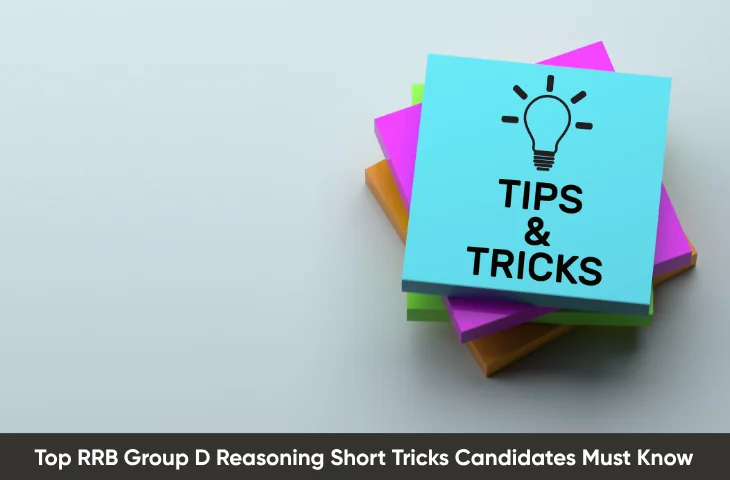RRB Group D Reasoning Short Tricks: Preparing for the Railway Recruitment Board (RRB) Group D exam? The General Intelligence & Reasoning section is one of your best opportunities to score quickly – if you use smart strategies. This article covers the essential RRB Group D Reasoning Short Tricks that can make a real difference in your performance.
Why Reasoning Shortcuts Matter?
In the RRB Group D Exam Pattern, reasoning typically carries around 30 questions of one mark each. Since there’s also negative marking, accuracy plus speed becomes crucial. By learning shortcuts and patterns, you:
- Solve more questions in less time
- Avoid getting stuck on longer logic problems
- Improve both speed and accuracy
With the right tricks, many topics become manageable without laborious step-by-step work.
Important Reasoning Topics for RRB Group D Exam
Given below is a table summarising the common topics and the sort of tricks you should focus on:
| Topics | What it Tests | Short-trick Focus |
| Analogies | Relationship between items (words, numbers, figures) | Recognise relationship type quickly, map it |
| Coding-Decoding | Letter/number shifts, symbol substitutions | Memorize common patterns, reduce rewriting |
| Number/Alphabet Series | Find next or missing term | Spot series type (addition, multiplication, mixed) rapidly |
| Blood Relations / Family Tree | Generational relation, find relation between two persons | Use simple pictorial tree or clue chart |
| Direction & Distance | Moves in NSEW, final position, right/left logic | Draw quick diagram, mark compass points |
| Syllogism / Statement-Conclusion | Logical deduction | Use Venn-diagram defaults or elimination method |
| Seating Arrangement / Puzzle | Complex arrangements, tables, rounds | Tabulate positions, use elimination order |
| Mirror / Water Images & Non-Verbal Reasoning | Visual/spatial reasoning | Visualize symmetry, use rule-based transformations |
Tried-and-Tested Short Tricks by Topic
Check out the tried and tested short tricks for the reasoning section that candidates must practice:
Number & Alphabet Series
These questions often follow a pattern: addition/subtraction, multiplication/division, alternating operations, squares/cubes, etc.
Short Tricks:
- Check differences between terms: if equal → simple addition/subtraction.
- Check ratio if multiplication/division.
- Check position: if numbers look like squares (4, 9, 16…), then next is next square.
- For mixed patterns: alternate operations. Example: 2, 6, 12, 20… ( +4, +6, +8 ) → next +10 = 30.
- For alphabet series: convert to positions (A = 1, B = 2…) to spot numeric pattern.
Coding and Decoding
These can be letter-shifts, mirror letters, symbol replacement, numeric codes.
Short Tricks:
- Quickly check if letters are shifted by +1, –1, or some fixed number.
- If digits used: check sum of digits, or multiply digits.
- Memorize common code keywords: e.g., “first letter is vowel & last is consonant then both coded as *” etc. (as seen in many practice sets)
- For symbol coding: map each symbol once, avoid rewriting full word every time.
Blood Relations & Family Trees
Given below is the short trick to find how two persons are related (father, mother, niece, etc.).
Short Trick:
- Use a simple tree or chart style: write the person, then create lines for father/mother, brother/sister etc.
- Mark generations with “↑” for parent and “↓” for child, “←→” for siblings.
- For statements like “A is father of B who is sister of C”, you can trace: B is female; father = A; sibling of B is C → thus C is also a child of A.
- Convert relational statements into a mini-diagram rather than mental juggling.
Syllogism & Venn “Statement-Conclusion”
These test logical relationships.
Short Tricks:
- Use two overlapping circles (Venn diagram) for two statements; mark all/none/some properly.
- For statement-conclusion: ask “Can we say this always true?” If no, discard.
- Default patterns: “All A are B” → circle of A inside B; “No A are B” → separate circles; “Some A are B” → overlap.
- Often quicker to eliminate impossible conclusions than prove possible ones.
Direction & Distance
Short Tricks:
- Always draw compasses: N, E, S, W.
- When description: “X walks 5 km north, then 3 km east…” mark the path.
- Look for relative position rather than computing full coordinates.
- If many moves, you can often combine: net north‐south and net east‐west moves.
Seating Arrangements / Puzzles
These are time-consuming without tricks.
Short Tricks:
- Always create a proper diagram (row, circle) with labels.
- Use elimination: list all persons, fill certain fixed positions first (e.g., “X sits at the corner”).
- Use shorthand: abbreviate names (e.g., A, B, C).
- Mark facing direction (if given) immediately, since “facing centre” vs “outside” changes diagram.
Mirror / Water Images & Non-Verbal Reasoning
Visual/spatial reasoning often appears in Group D.
Short Tricks:
- For mirror images: imagine a vertical line; left becomes right.
- For water images: flip vertically; top becomes bottom.
- For paper-folding/cutting: count how many folds & how resultant holes appear.
- Memorize basic transformations for quick elimination.
Strategy to Apply these Tricks in the exam
Check out the given strategies below for the upcoming RRB Group D exam 2025:
- Scan the questions in the reasoning section first; mark easy ones (series, analogy) to do immediately.
- Use shortcuts first for those you recognise; aim to solve within <1 minute each.
- For complex puzzles or seating problems, decide quickly whether to attempt now or leave for later; don’t get stuck.
- Maintain accuracy. Because of negative marking (-0.25 for wrong) you cannot afford random guessing.
- Keep error-log during practice: note recurring mistakes (e.g., wrong direction mapping, mis-diagramming).
- Time-based practice: simulate exam conditions; speed comes with timed drills.
Common Mistakes to Avoid
There are certain mistakes that candidates must try to avoid. These include:
- Over-writing: writing full trees or text instead of sketching diagram.
- Ignoring the question stem’s keywords like “only”, “all”, “some”.
- Starting a tough puzzle without marking it as “skip if > 2 min”.
- Guessing blindly; since negative marking penalises.
- Ignoring non-verbal questions during preparation (pattern recognition still improves speed).
Summary
The important points of RRB Group D Reasoning Short Tricks are summarized below:
- The reasoning section offers a scoring opportunity if you apply short tricks and manage time.
- Prioritise high-frequency topics: analogies, series, coding-decoding, blood relations, direction sense, syllogism.
- Use diagrammatic/pictorial methods for family trees, seating, and direction; avoid lengthy text.
- Memorise and practise systematic shortcuts for series and coding/decoding.
- Time management is critical: recognise what you can solve quickly and what to skip.
- Accuracy and practice go hand-in-hand; keep reviewing your performance, maintain error logs.
Mastering the RRB Group D Reasoning Short Tricks transforms the reasoning section from a time drain into a confidence-booster. With the right approach—focused preparation, adherence to shortcuts, and disciplined practice—you can convert this section into one of your strongest. Incorporate these strategies, train consistently, and walk into the exam with a clear plan.
FAQs
The most scoring and frequently asked topics include Analogy, Series (Number & Alphabet), Coding-Decoding, Blood Relation, Direction Sense, Syllogism, and Seating Arrangement. These topics together cover more than 70% of the reasoning section in most RRB Group D exams.
To improve speed, practice short tricks regularly – especially for number and alphabet series. Use shortcut diagrams for blood relations and directions, and avoid reading entire problems repeatedly. Daily mock tests and timed quizzes also help improve accuracy and response time.
Not all. Instead of memorising every trick, understand the logic behind common reasoning patterns. Once you grasp the concept (for example, alphabet shifts in coding-decoding), you can easily apply it to different variations of questions.
In the RRB Group D exam, ideally, 20–25 minutes are enough for reasoning if you use shortcuts effectively. Attempt easy questions first – like analogy and series – then move to puzzles or seating arrangements that take slightly more time.
You can find reliable reasoning short tricks and practice questions on official RRB preparation platforms and trusted learning websites.
- RRB NTPC City Intimation Slip 2025, Check Exam Centres
- RRB NTPC Medical Test 2025, Check Post Wise Medical Criteria
- RRB NTPC Undergraduate Notification 2025, Apply for 3058 Posts
- RRB NTPC परीक्षा के लिए स्टेटिक जीके टॉपिक, यहां जानिए सभी टॉपिक्स
- RRB NTPC vs SSC CGL vs IBPS Clerk, Check Complete Analysis
- Importance of RRB NTPC Psycho Test, Know the Details of Test

Hello! This is Arijit Dutta. I am a skilled Content Writer at Oliveboard with nearly 3+ years of experience in crafting engaging, informative, and exam-focused content for the Railways Domain. With a strong command of language and a keen understanding of learner needs, I contribute significantly to Oliveboard’s mission of delivering high-quality educational resources. Passionate about clear communication and continuous learning, I consistently create content that helps government job aspirants achieve their goals. Outside of work, I enjoy playing cricket and listening to music, which helps me stay balanced and creative in my professional journey.
